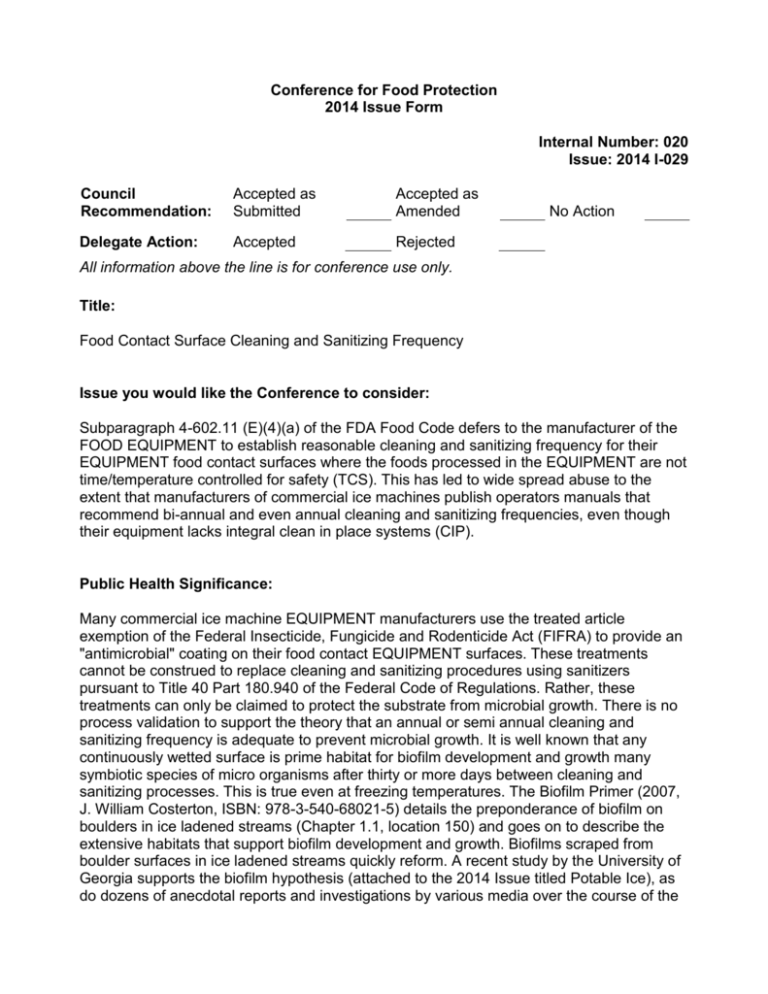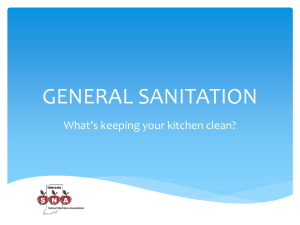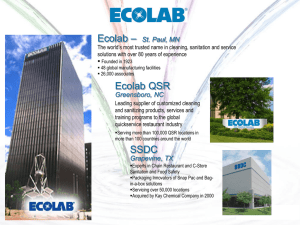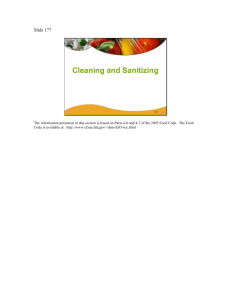File with Tracking - Conference for Food Protection
advertisement

Conference for Food Protection 2014 Issue Form Internal Number: 020 Issue: 2014 I-029 Council Recommendation: Accepted as Submitted Accepted as Amended Delegate Action: Accepted Rejected No Action All information above the line is for conference use only. Title: Food Contact Surface Cleaning and Sanitizing Frequency Issue you would like the Conference to consider: Subparagraph 4-602.11 (E)(4)(a) of the FDA Food Code defers to the manufacturer of the FOOD EQUIPMENT to establish reasonable cleaning and sanitizing frequency for their EQUIPMENT food contact surfaces where the foods processed in the EQUIPMENT are not time/temperature controlled for safety (TCS). This has led to wide spread abuse to the extent that manufacturers of commercial ice machines publish operators manuals that recommend bi-annual and even annual cleaning and sanitizing frequencies, even though their equipment lacks integral clean in place systems (CIP). Public Health Significance: Many commercial ice machine EQUIPMENT manufacturers use the treated article exemption of the Federal Insecticide, Fungicide and Rodenticide Act (FIFRA) to provide an "antimicrobial" coating on their food contact EQUIPMENT surfaces. These treatments cannot be construed to replace cleaning and sanitizing procedures using sanitizers pursuant to Title 40 Part 180.940 of the Federal Code of Regulations. Rather, these treatments can only be claimed to protect the substrate from microbial growth. There is no process validation to support the theory that an annual or semi annual cleaning and sanitizing frequency is adequate to prevent microbial growth. It is well known that any continuously wetted surface is prime habitat for biofilm development and growth many symbiotic species of micro organisms after thirty or more days between cleaning and sanitizing processes. This is true even at freezing temperatures. The Biofilm Primer (2007, J. William Costerton, ISBN: 978-3-540-68021-5) details the preponderance of biofilm on boulders in ice ladened streams (Chapter 1.1, location 150) and goes on to describe the extensive habitats that support biofilm development and growth. Biofilms scraped from boulder surfaces in ice ladened streams quickly reform. A recent study by the University of Georgia supports the biofilm hypothesis (attached to the 2014 Issue titled Potable Ice), as do dozens of anecdotal reports and investigations by various media over the course of the past two decades. Channel 2, WSB TV in Atlanta Georgia ran the following story on November 14th, 2013: Chinese Restaurant Scores 55 after mold found in ice machine". In another report, a 15-year-old Arizona boy died from pulmonary aspiration after being infected by Norovirus that was epidemiological traced to the interior surfaces of an ice cooler (http://www.nbcnews.com/id/13775964/). In a separate report, Legionella pneumophila was also found in ice machines and was identified by epidemiological survey in a Legionellosis transmission to patients in a hospital (http://www.cdc.gov/mmwr/preview/mmwrhtml/mm5831a2.htm). This risk of food contact surface contamination is amplified whenever there is live yeast from brewing or baking on site. This risk is well known in Las Vegas and throughout the Southern Nevada Health District and everywhere else where inspectors take appropriate care to examine these food contact surfaces. Every experienced operator with ice making EQUIPMENT is familiar with the molds and biofilms characteristically found in this equipment. The mold and organic biofilm matter invariably ends up in the ice that is then served for human consumption. These contaminants can be controlled either with increased cleaning and sanitizing frequency or automatic in place cleaning and sanitizing systems. This gap in food safety begs correction by revision to the FDA Food Code. Recommended Solution: The Conference recommends...: that a letter be sent to FDA amending Subparagraph 4-602.11 (E)(4) of the 2013 FDA Food Code as follows (strikethrough format used for deleted language and underlining to add new language): (4) In EQUIPMENT such as ice bins and BEVERAGE dispensing nozzles and enclosed components of EQUIPMENT such as ice makers, cooking oil storage tanks and distribution lines, BEVERAGE and syrup dispensing lines or tubes, coffee bean grinders, and water vending EQUIPMENT: (a) At a frequency specified by the manufacturer, or (b) Absent manufacturer specifications, at a frequency necessary to preclude accumulation of soil or mold. (c) Manufacturer's of Ice Machines must state in their EQUIPMENT owners manuals the minimum required cleaning and sanitizing frequencies, methods and means necessary to preclude food contact surface contamination from the growth of biofilms in their EQUIPMENT as is demonstrated by a third party laboratory process validation. Submitter Information: Name: Thomas Johnson Organization: Johnson Diversified Products, Inc. Address: 1408 Northland Dr 406 City/State/Zip: Mendota Heights, MN 55120 Telephone: E-mail: 651-587-0418 Fax: tomj@jdpinc.com 651-686-7670 It is the policy of the Conference for Food Protection to not accept Issues that would endorse a brand name or a commercial proprietary process.









